Honor Award
The Qinhuangdao Beach Restoration:
An Ecological Surgery
Qinhuangdao City, Hebei Province, China
Turenscape, China and Peking University Graduate School of Landscape Architecture
Client: The Municipal Government of Qinhuangdao City
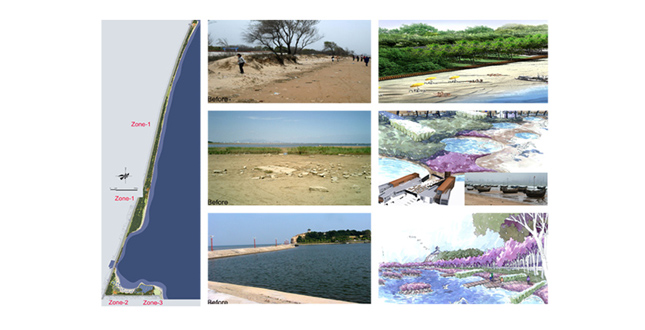 Close Me!
Close Me!Site plan and regenerative design strategies for three sections along the shore: to stop soil erosion, renew dying vegetation, rehabilitate the damaged shoreline, and recover a wetland through an integrated education facility.
Download Hi-Res ImagePhoto: Kongjian Yu
Photo 1 of 15
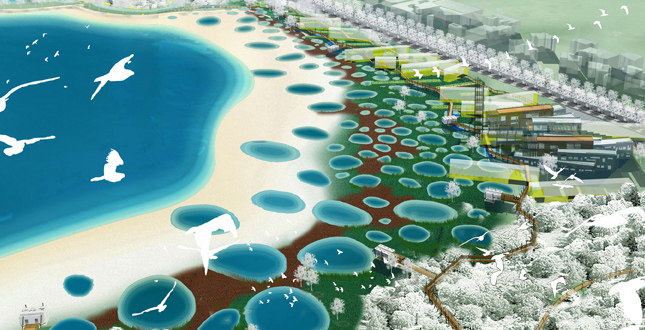 Close Me!
Close Me!Computer rendering bird’s-eye view of Zone 2 and Zone 3 showing the recovered wetland on the right, the islets dotting the lake to the upper left, and an educational facility at center right.
Download Hi-Res ImagePhoto 2 of 15
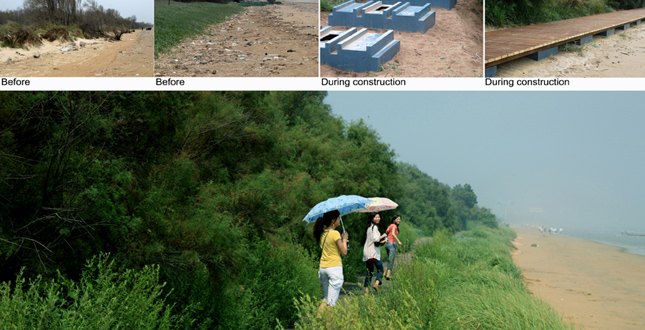 Close Me!
Close Me!The boardwalk now (bottom) in comparison with the existing site conditions (top): The regenerative design strategy mitigates beach erosion and helps recover the dying vegetation through careful installation using "floating" bases made of fiberglass.
Download Hi-Res ImagePhoto: Kongjian Yu
Photo 3 of 15
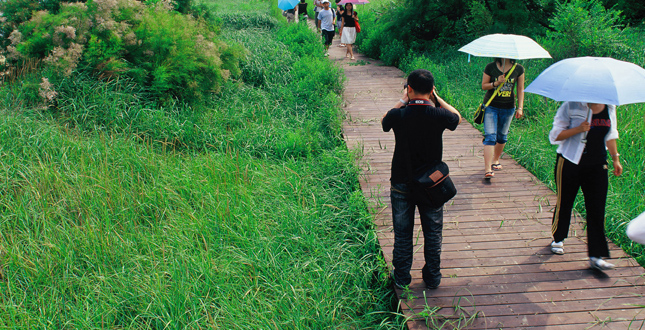 Close Me!
Close Me!The sensitively installed boardwalk has become a tourist attraction and an educational router that links the coastal ecosystems and provides breathtaking views of the ocean.
Download Hi-Res ImagePhoto: Kongjian Yu
Photo 4 of 15
 Close Me!
Close Me!The sensitively installed boardwalk has become a tourist attraction and an educational route that links the coastal ecosystems and provides breathtaking views of the ocean.
Download Hi-Res ImagePhoto: Kongjian Yu
Photo 5 of 15
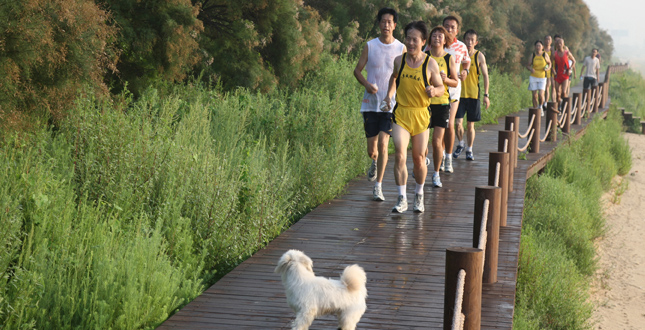 Close Me!
Close Me!A formerly inaccessible and heavily eroded beach has now become a favorite place for outdoor recreation for local communities.
Download Hi-Res ImagePhoto: Kongjian Yu
Photo 6 of 15
 Close Me!
Close Me!A pavilion surrounded by the tamarisk community (Tamarix chinensis), one of seven pavilions carefully sited at strategic points for scenic views and environmental education.
Download Hi-Res ImagePhoto: Kongjian Yu
Photo 7 of 15
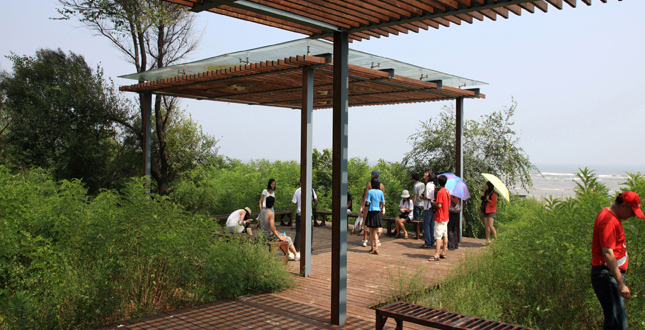 Close Me!
Close Me!One of the pavilions carefully sited at one of seven strategic points for scenic views has become an attraction and resting place for tourists while offering environmental education.
Download Hi-Res ImagePhoto: Kongjian Yu
Photo 8 of 15
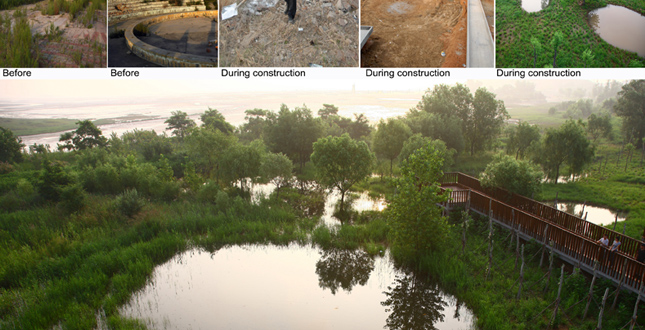 Close Me!
Close Me!The recovered wetland (bottom) in comparison with the previous site conditions (top): The site was an abandoned theme park built on a coastal wetland. Ponds were constructed using building debris to capture stormwater runoff.
Download Hi-Res ImagePhoto: Kongjian Yu
Photo 9 of 15
 Close Me!
Close Me!By capturing stormwater using "bubbles," diverse wetland habitats replace the formerly degraded and barren beach.
Download Hi-Res ImagePhoto: Kongjian Yu, Cao Yang
Photo 10 of 15
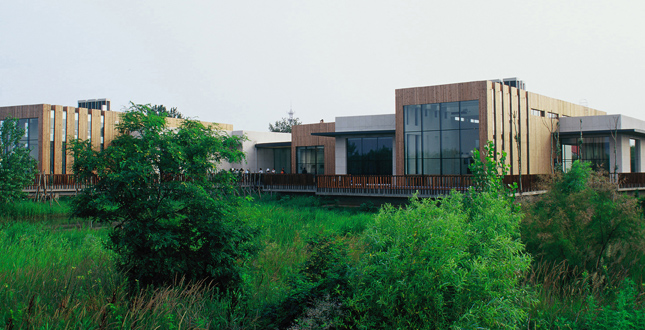 Close Me!
Close Me!The Wetland Museum was designed as an integral part of the wetland; its interlocking form was inspired by the fishing boats anchoring ashore against the wind and waves to keep stable, while enjoying the breeze from the ocean.
Download Hi-Res ImagePhoto: Kongjian Yu
Photo 11 of 15
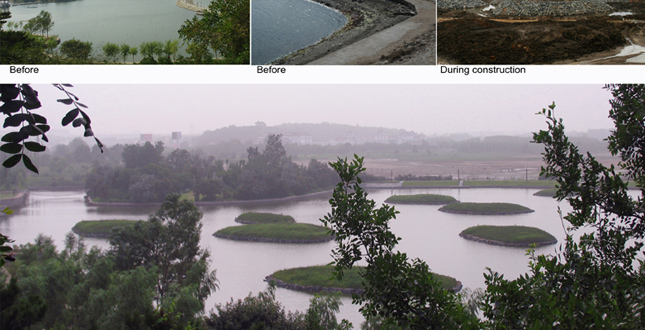 Close Me!
Close Me!The improved lake view (bottom) in comparison with the previous site conditions (top): Islets have been constructed for bird habitat and to enhance the view; the concrete embankment has been replaced with ecofriendly riprap.
Download Hi-Res ImagePhoto: Kongjian Yu
Photo 12 of 15
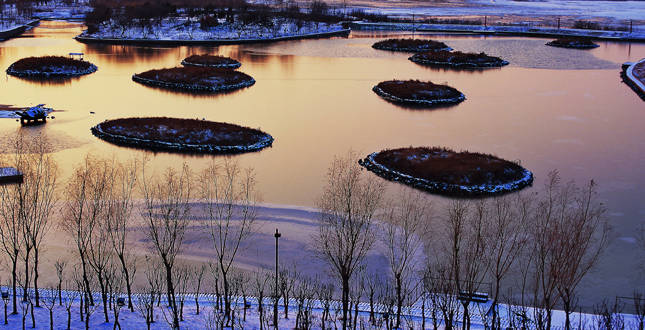 Close Me!
Close Me!The winter view of the islets dotting the lake.
Download Hi-Res ImagePhoto: Cao Yang
Photo 13 of 15
 Close Me!
Close Me!The former concrete embankment (top) has been replaced with an ecofriendly riprap, boardwalk, and native vegetation (bottom, view facing west). The lighting structures are existing.
Download Hi-Res ImagePhoto: Kongjian Yu
Photo 14 of 15
 Close Me!
Close Me!The former concrete embankment has been replaced with an ecofriendly riprap, boardwalk, and native vegetation (view facing west). The lighting structures are existing.
Download Hi-Res ImagePhoto: Kongjian Yu
Photo 15 of 15
Project Statement
Using various regenerative design techniques, a heavily eroded, badly abused and decaying beach has been ecologically recovered and successfully transformed into an aethestically pleasing and well-visited place, demonstrating landscape architects can professionally facilitate the initiatives of rebuilding a harmonious relationship between man and nature through ecological design.
Project Narrative
—2010 Professional Awards Jury
The beach is located along the Bohai Sea shoreline of Qinhuangdao City, a touristic coastal city in North China's Hebei Province, 6.4 kilometers in length and an area of 60 hectares. The whole site was in an environmentally and ecologically damaged condition. The coastal sand dunes were heavily eroded, the coastal vegetation was decaying and the beach was deserted and littered. Prior unwise development had destroyed the coastal wetland and left it full of debris.
The intention of this project is to rehabilitate the damaged natural environment, restore and unveil to tourists and local residents the beauty of the site while transforming a former degraded beach into an ecologically healthy and aesthetically attractive landscape.
The whole site can be divided into three zones:
Zone 1: Erosion Protection
This is basically a windy shoreline about five kilometers long, covered with coastal sand dunes and diverse plant communities which have adapted themselves to various site conditions including wetland communities of cattail (Typha angustifolia), sand dunes grass communities, Amorpha shrub (Amorpha fruiticosa), Chinese tamarisk (Tamarix chinensis) groves, forests of black locust (Robinia pseudoacacia), and willow (Salix matsudana).
For a long time, this shore line had been deserted, heavily eroded and littered, and almost inaccessible to tourists and local residents. The design solution has carefully arranged a boardwalk that winds along the shoreline, linking different patches of plant communities. This boardwalk not only allows visitors to experience the different plant communities on the way, but also acts as a soil conservation installation that protects the shoreline from the erosion caused by the ocean wind and weave.
Ecofriendly bases are designed using fiberglass that allows the boardwalk to "float" above the sand dunes and wetland. The fiberglass bases are specially prefabricated containers that can be filled with sand or be empty depending on the soil conditions. This innovative and now patented (by the landscape architect) technique not only makes the process of boardwalk installation much easier in a natural environment than the conventional construction approach, which could be a harder task, but also makes minimum impact to the environment.
Resting pavilions, shading structures and environmental interpretation systems are designed along the boardwalk that are carefully sited for the scenery, allowing visitors to visualize the ecological meaning of the site and highlighting their panoramic beauty. These pavilions become attractive focal points for tourists and the local residents who come in groups to enjoy the landscape and recreate.
Zone 2: A Recovered Wetland
The central zone is where the new bird museum is built. It was a degraded coastal wetland as well, adjacent to an intertidal zone that had been listed as a national bird reserve. This site was an abandoned construction site from a former theme park, which destroyed the coastal wetland habitats when built. The site was also covered with building debris and garbage.
Ecological recovery was a strong need, so the landscape architect searched for an idea that could be natural, social and economically sustainable: A Wetland Museum was built on this site as an education facility in association with the bird reserve beyond.
Inspired by the bubble-patterned water sinks along the intertidal zone, water holes are created in among the building debris to catch the rainwater from the land that allows wetland plant and animal communities to get established, also attracting birds to forage.
The Wetland Museum is designed as an integral part of the landscape, stretching into the wetland, and inlets breeze from the ocean to cool off the hot summer and reduce the use of energy in the building. The interlocking pattern of the building and its environment was inspired by the local fishing boats anchoring in group off the shore, in an image against the wind and waves that keep the boats stable in the water.
A system of boardwalks and platforms is built allowing people to walk from the building into the wetland and enjoy the newly created habitats and diverse species.
Zone 3: The Dotted Isles Lake and Ecofriendly Riprap
This zone is at the very east end of the project. It was previously a park constituted by a heavy concrete embankment which was built to protect the shoreline from erosion and to create a lake by trapping the seawater during the high tide. This park was certainly not satisfying, neither in ecological or aesthetical terms. The concrete embankment was boring and barren and the Lake was empty and bounded by rigid concrete shoreline. The regenerative design strategies include demolishing the concrete and replacing it with ecologically friendly riprap. A boardwalk is built to replace the hard pavement, and native ground cover is introduced to green the surface alongside the boardwalk. In addition, nine green islets are created in the middle of the lake to enrich the empty and boring water surface allowing birds to rest and nest.
The results of these ecological restoring designs are remarkably successful. The erosion of the shoreline has been effectively controlled, the degraded coastal wetland has been restored successfully, the boring and ecologically dead concrete embankment has been ecologically rehabilitated. A continuous boardwalk links various coastal plant communities, giving tourists an unforgettable educational and aesthetic experience; the bird museum becomes an integral part of the coastal landscape that breathes with the ocean and acts as a focal point along the linear ecological and scenic beach. This project demonstrates how landscape architects can incorporate ecology, engineering, innovative technique and design elements into an effective regenerative operation on a damaged landscape, and transform the degraded man–nature relationship into a sustainable and harmonious one.
Project Resources
Design Principal
Kongjian Yu, International ASLA
Design Team
Lin Shihong, Hong Wei, Ning Weijiing,Yu Hongqian, Qiu Yu, Engineer, Shao Zongbo, Liu Zhiming, Zhang Jin, Weng Yujia, Zhang Yuan, Yang Zhenrong, Bian Wenguang, Xu Yingjun, Zhang Junying
Construction Managers and Client
Yang Lina, Jiang Hongfen, Jin Zhongge,
Fu Xiujun






